


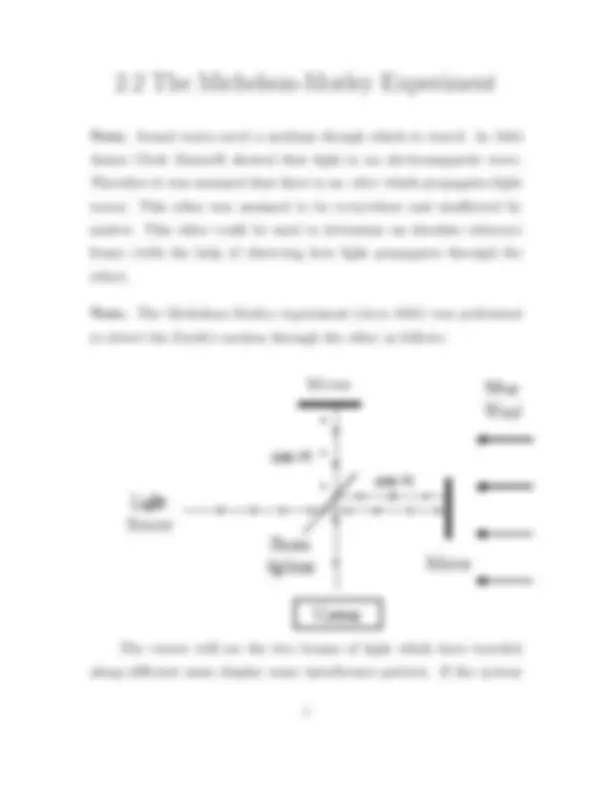
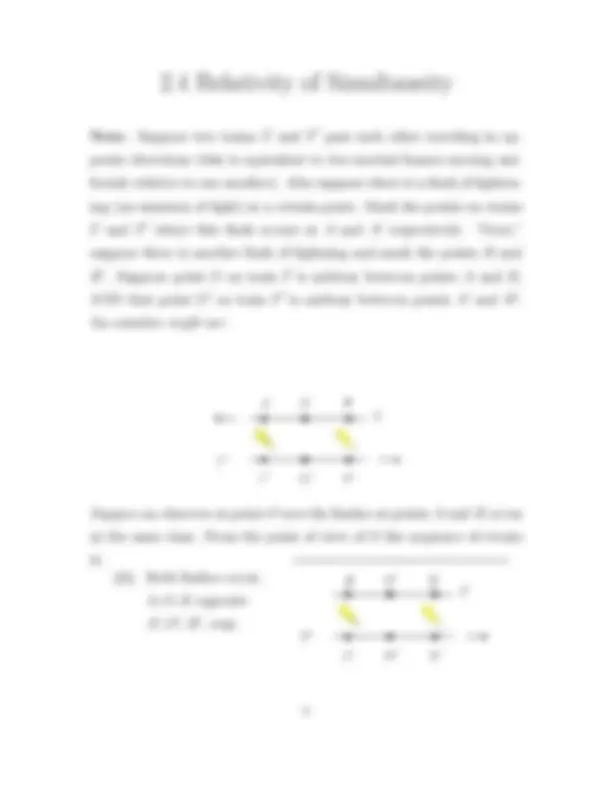
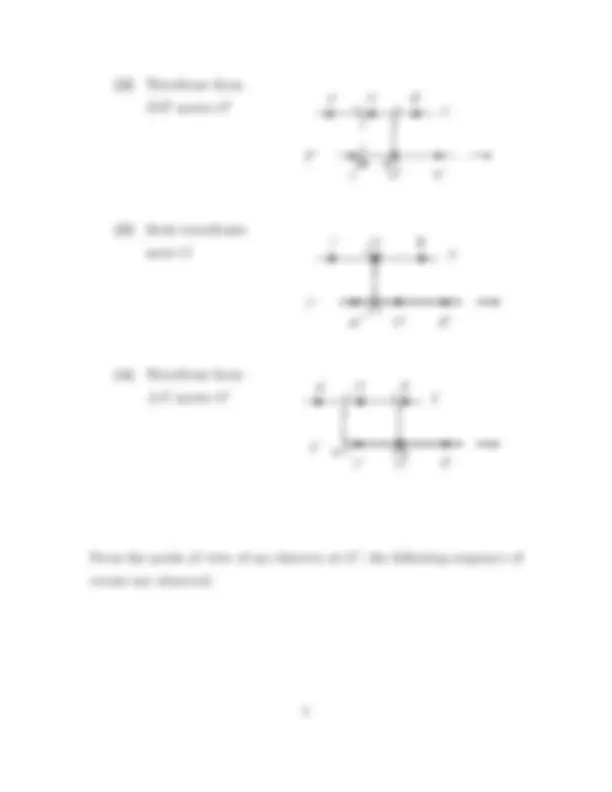
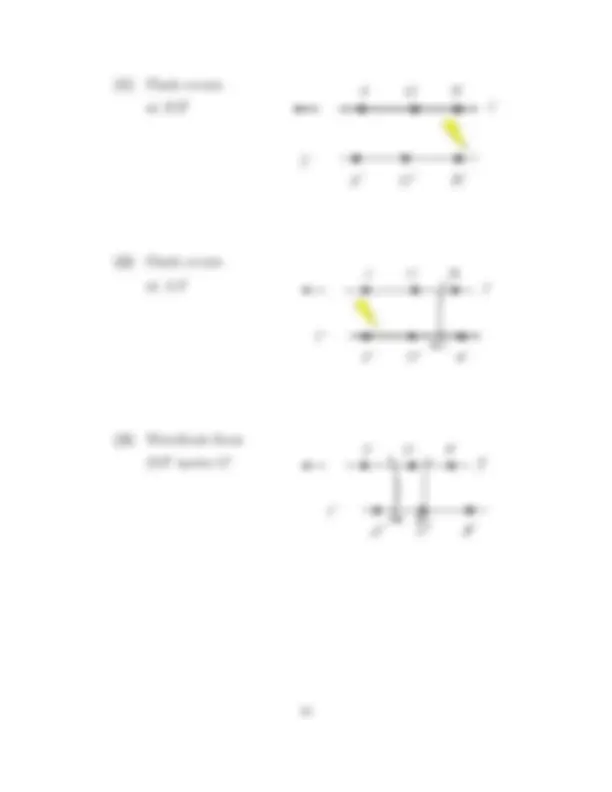

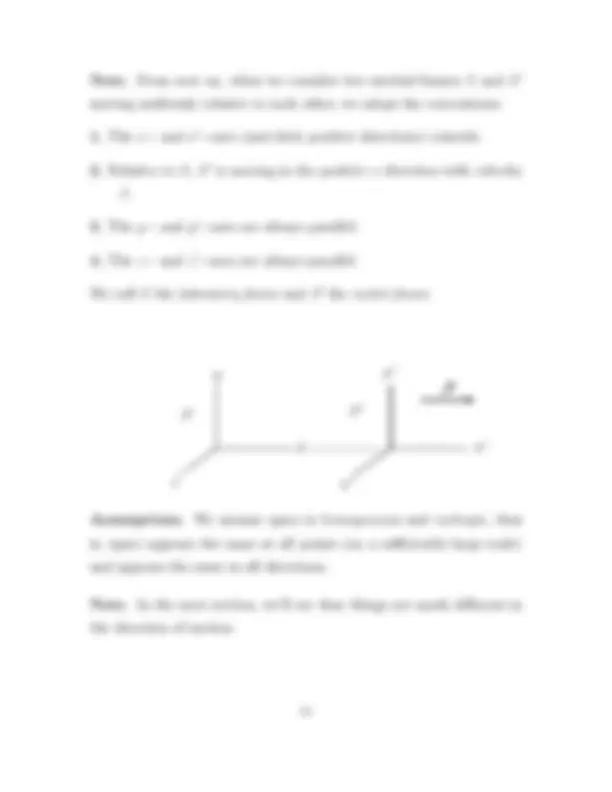
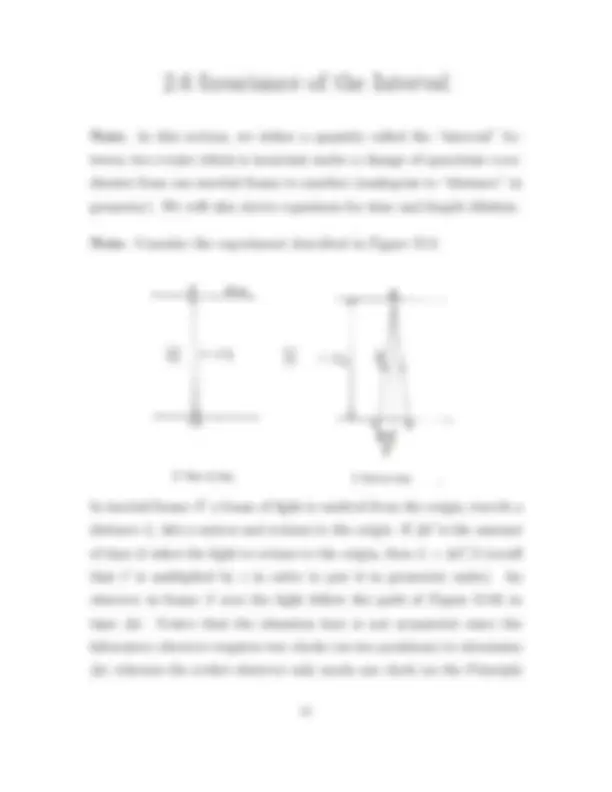
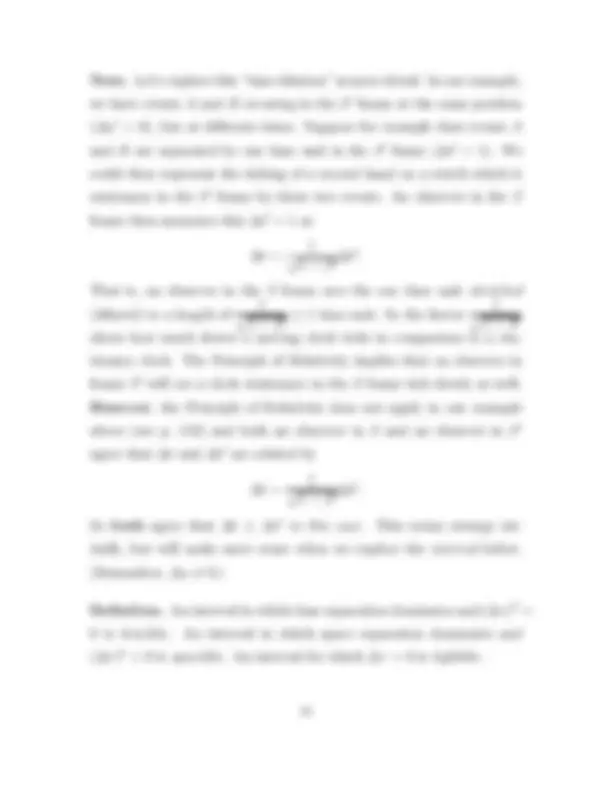
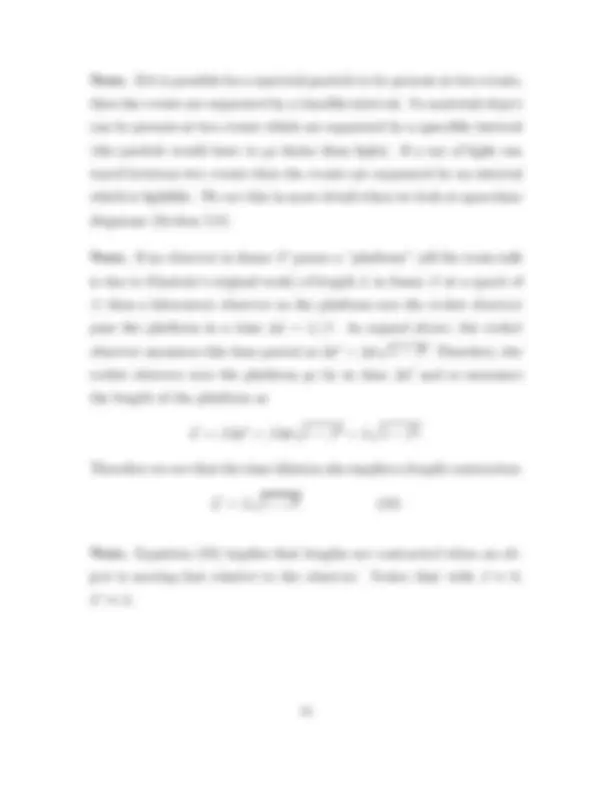
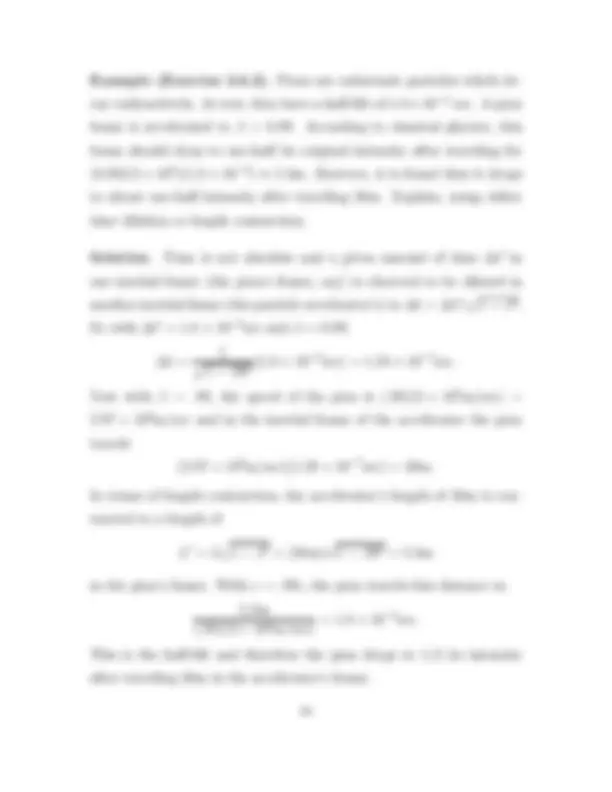
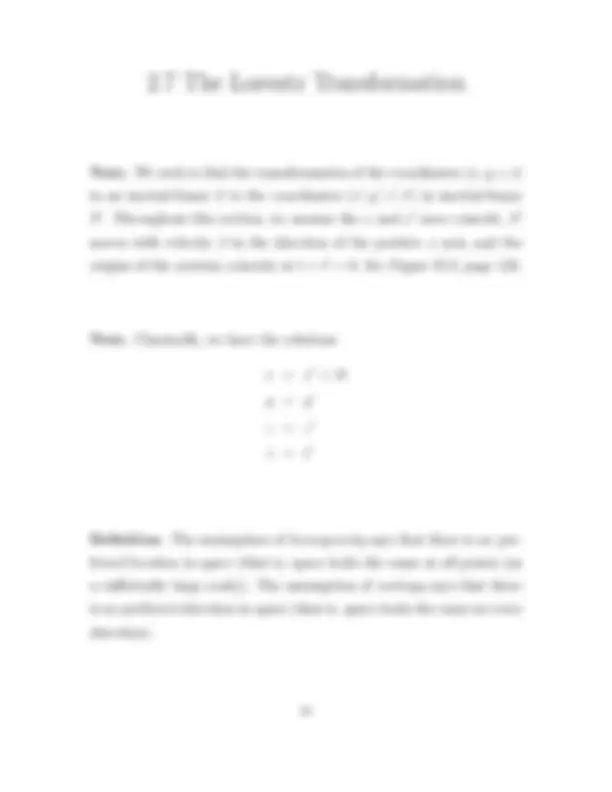
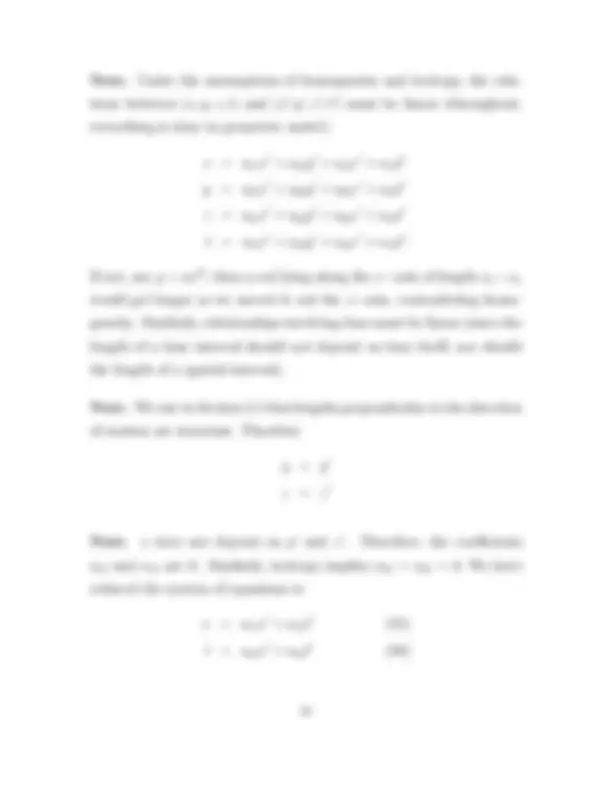
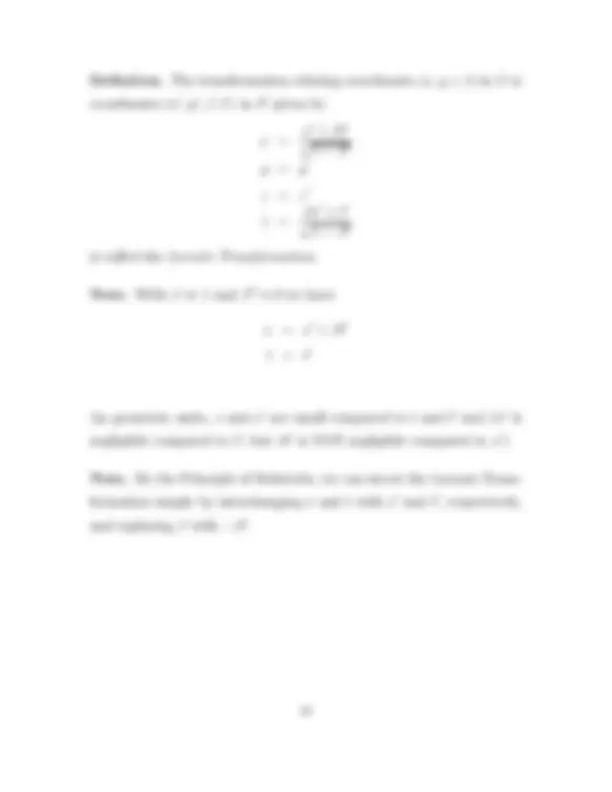
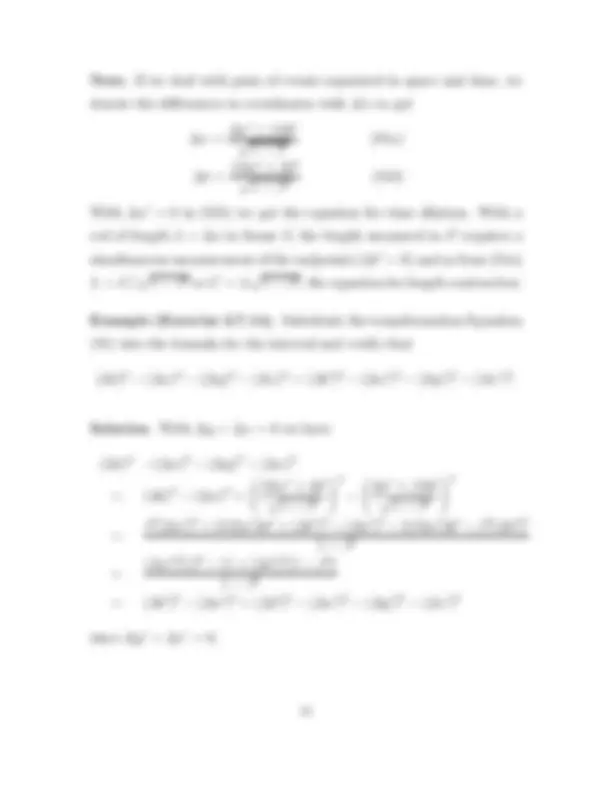
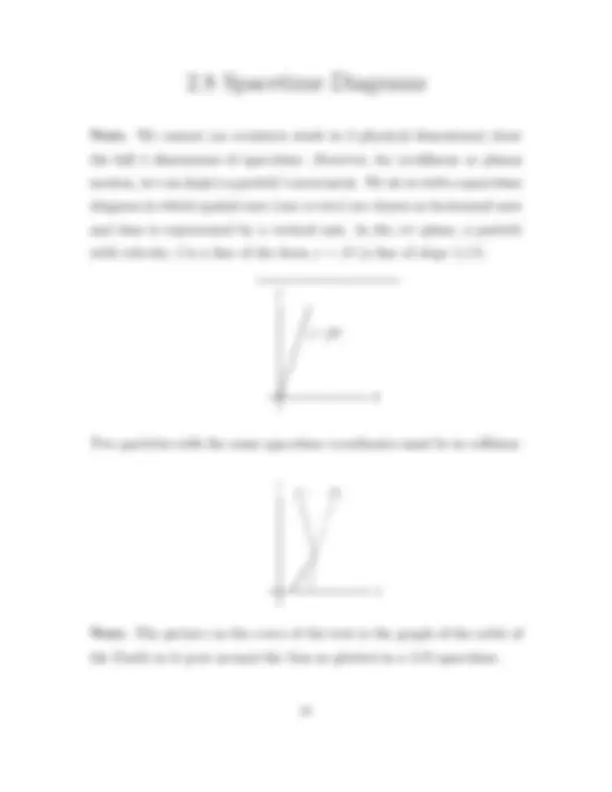
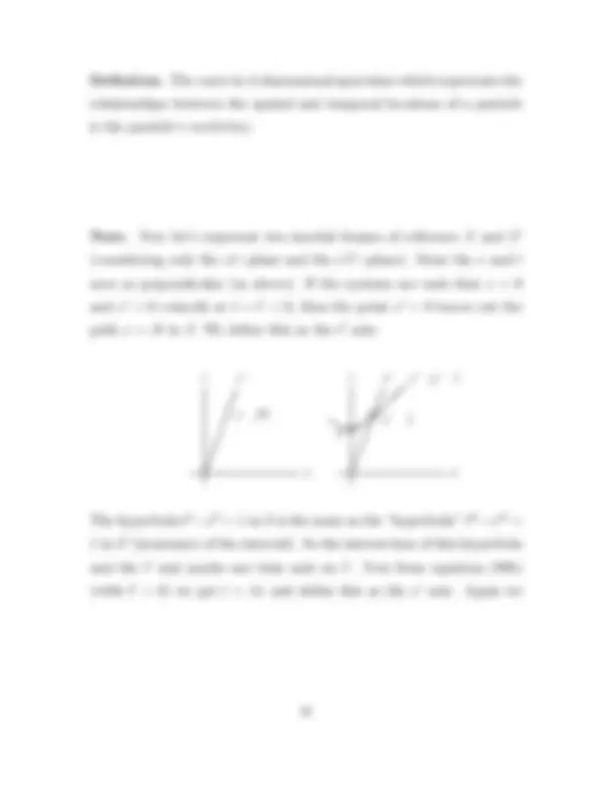
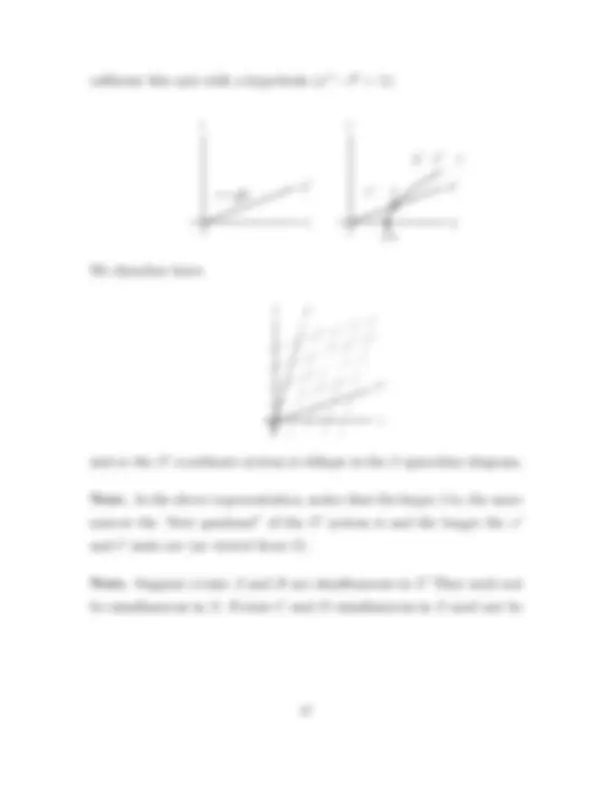
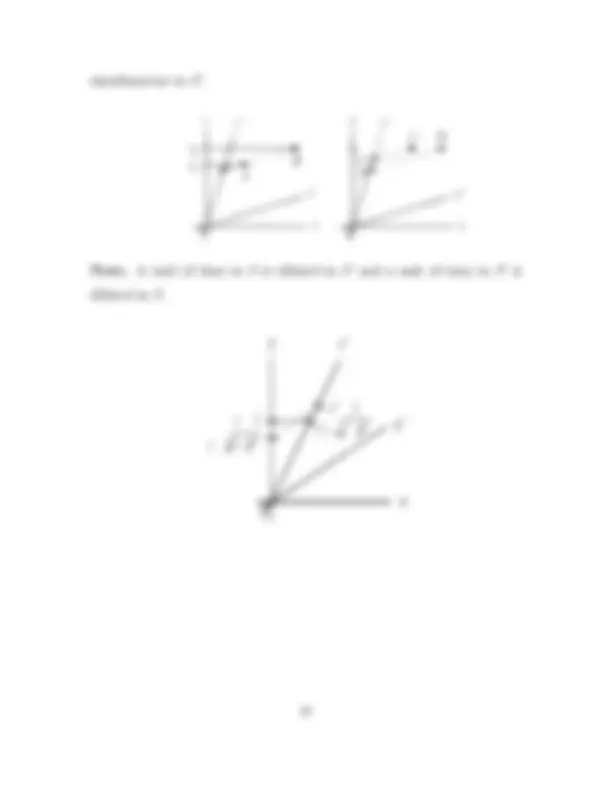
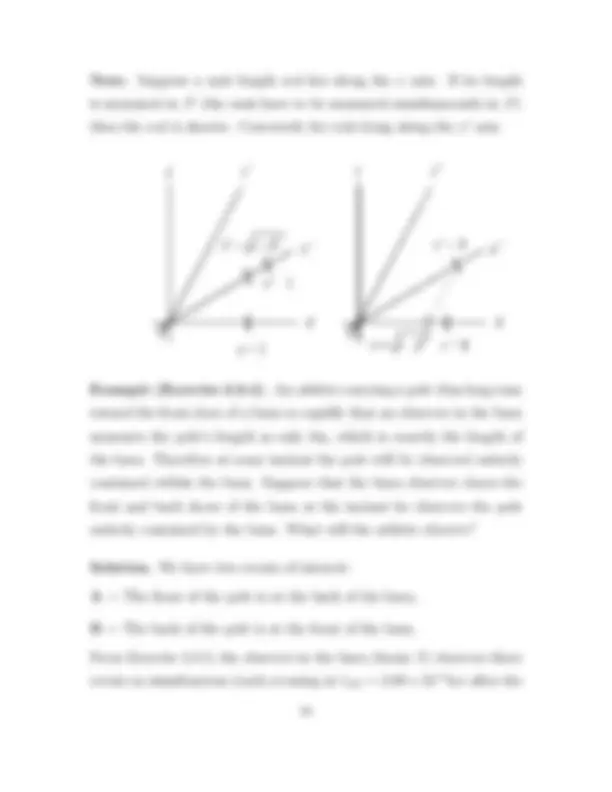
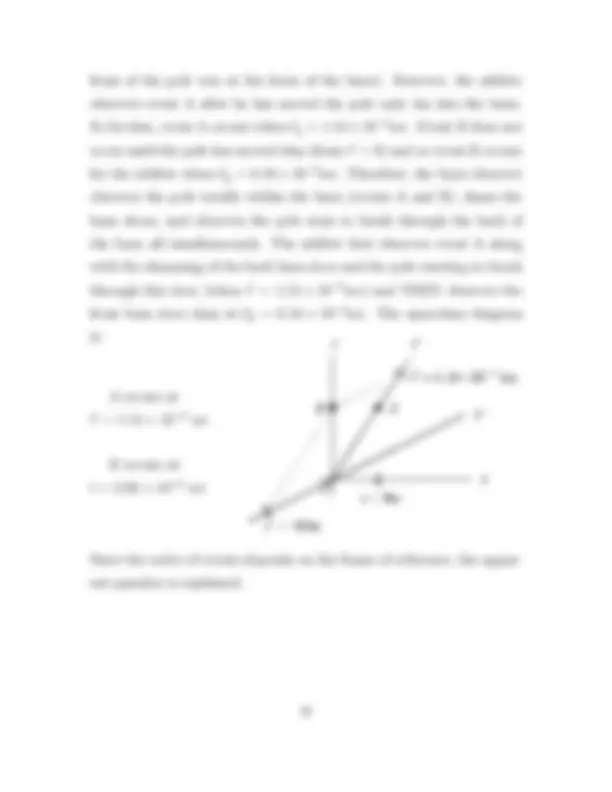
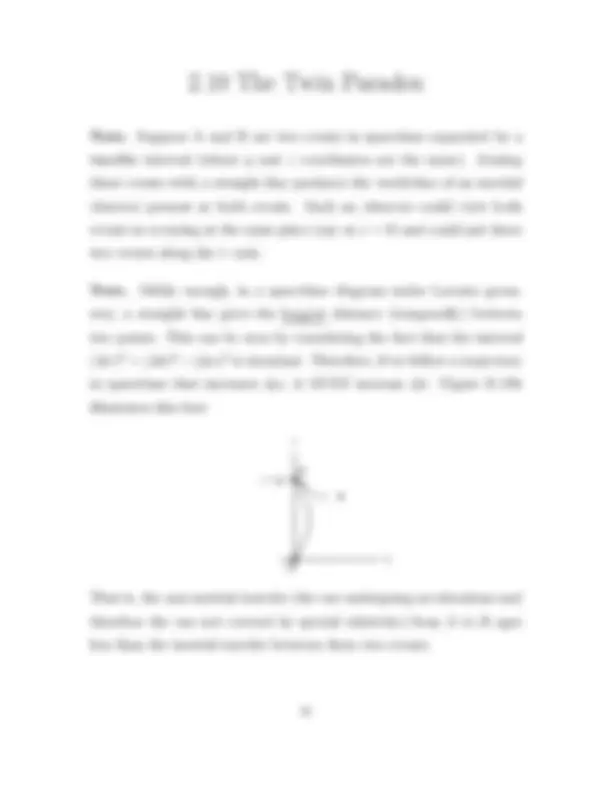

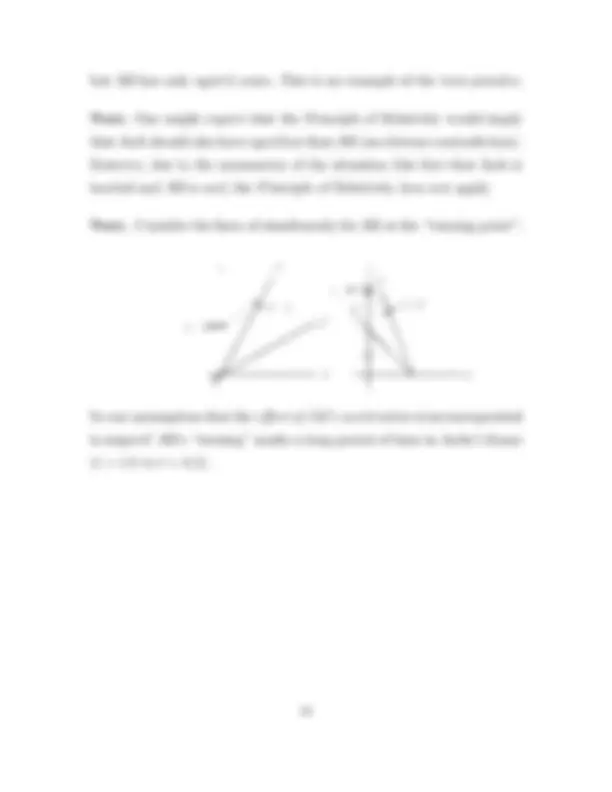
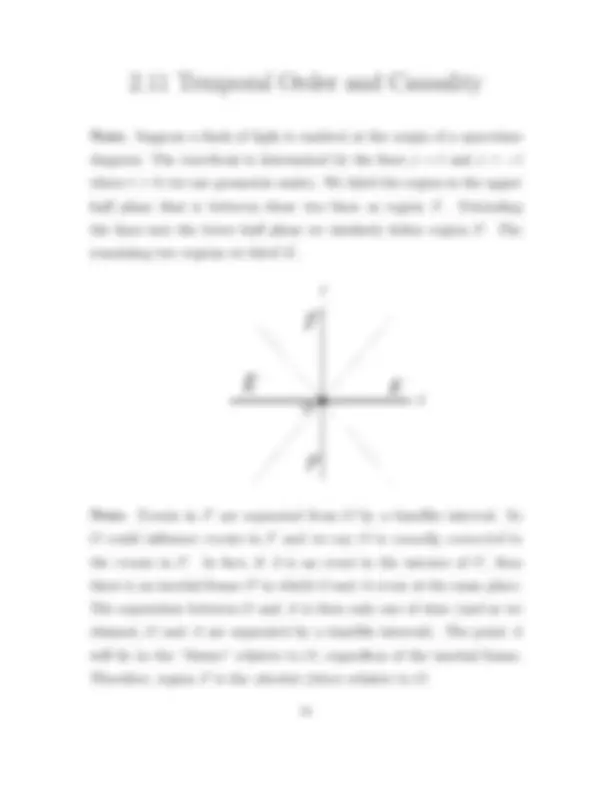



Study with the several resources on Docsity

Earn points by helping other students or get them with a premium plan


Prepare for your exams
Study with the several resources on Docsity

Earn points to download
Earn points by helping other students or get them with a premium plan
Community
Ask the community for help and clear up your study doubts
Discover the best universities in your country according to Docsity users
Free resources
Download our free guides on studying techniques, anxiety management strategies, and thesis advice from Docsity tutors
Material Type: Notes; Class: Great Ideas in Science; Subject: Physics (PHYS); University: East Tennessee State University; Term: Unknown 2018;
Typology: Study notes
1 / 35

This page cannot be seen from the preview
Don't miss anything!




























Note. Classically (i.e in Newtonian mechanics), space is thought of as
This would imply that one could set up a system of spatial coordinates (x, y, z) and describe any dynamical event in terms of these spatial coordinates and time t.
Note. Newton’s Three Laws of Motion:
Definition. A frame of reference is a system of spatial coordinates and possibly a temporal coordinate. A frame of reference in which the Law of Inertia holds is an inertial frame or inertial system. An observer at rest (i.e. with zero velocity) in such a system is an inertial observer.
Note. The main idea of an inertial observer in an inertial frame is that the observer experiences no acceleration (and therefore no net force). If S is an inertial frame and S′^ is a frame (i.e. coordinate system) moving uniformly relative to S, then S′^ is itself an inertial frame. Frames S and S′^ are equivalent in the sense that there is no mechanical experiment that can be conducted to determine whether either frame is at rest or in uniform motion (that is, there is no preferred frame). This is called the Galilean (or classical) Principle of Relativity.
Note. Special relativity deals with the observations of phenomena by inertial observers and with the comparison of observations of inertial observers in equivalent frames (i.e. NO ACCELERATION!). General relativity takes into consideration the effects of acceleration (and there- fore gravitation) on observations.
Note. Sound waves need a medium though which to travel. In 1864 James Clerk Maxwell showed that light is an electromagnetic wave. Therefore it was assumed that there is an ether which propagates light waves. This ether was assumed to be everywhere and unaffected by matter. This ether could be used to determine an absolute reference frame (with the help of observing how light propagates through the ether).
Note. The Michelson-Morley experiment (circa 1885) was performed to detect the Earth’s motion through the ether as follows:
The viewer will see the two beams of light which have traveled along different arms display some interference pattern. If the system
Note. Albert Einstein published “Zur Elektrodynamik bewegter K¨orper” (On the Electrodynamics of Moving Bodies) in Annalen der Physik (An- nals of Physics) 17 (1905). In this paper, he established the SPECIAL THEORY OF RELATIVITY! I quote (from “The Principles of Relativity” by H. A. Lorenz, A. Einstein, H. Minkowski, and H. Weyl, published by Dover Publications): “...the same laws of electrodynamics and optics will be valid for all frames of reference for which the equations of me- chanics hold good. We raise this conjecture (the purport of which will hereafter be called the “Principle of Relativity”) to the status of a postulate, and also introduce another postulate, which is only apparently irreconcilable with the former, namely, that light is always propagated in empty space with a definite velocity c which is independent of the state of motion of the emitting body.” In short:
P1. All physical laws valid in one frame of reference are equally valid in any other frame moving uniformly relative to the first.
P2. The speed of light (in a vacuum) is the same in all inertial frames of reference, regardless of the motion of the light source.
From these two simple (and empirically varified) assumptions arises the beginning of the revolution that marks our transition from classical to modern physics!
Note. Suppose two trains T and T ′^ pass each other traveling in op- posite directions (this is equivalent to two inertial frames moving uni- formly relative to one another). Also suppose there is a flash of lighten- ing (an emission of light) at a certain point. Mark the points on trains T and T ′^ where this flash occurs at A and A′^ respectively. “Next,” suppose there is another flash of lightning and mark the points B and B′. Suppose point O on train T is midway between points A and B, AND that point O′^ on train T ′^ is midway between points A′^ and B′. An outsider might see:
Suppose an observer at point O sees the flashes at points A and B occur at the same time. From the point of view of O the sequence of events is: (1) Both flashes occur, A, O, B opposite A′, O′, B′, resp.
(1) Flash occurs at BB′
(2) Flash occurs at AA′
(3) Wavefront from BB′^ meets O′
(4) Wavefronts from AA′^ and BB′^ meet O
(5) Wavefront from AA′^ meets O′
Notice that the speed of light is the same in both frames of reference. However, the observer on train T sees the flashes occur simultaneously, whereas the observer on train T ′^ sees the flash at BB′^ occur before the flash at AA′. Therefore, events that appear to be simultaneous in one frame of reference, may not appear to be simultaneous in another. This is the relativity of simultaneity.
Definition. In 3-dimensional geometry, positions are represented by points (x, y, z). In physics, we are interested in events which have both time and position (t, x, y, z). The collection of all possible events is spacetime.
Definition. With an event (t, x, y, z) in spacetime we associate the units of cm with coordinates x, y, z. In addition, we express t (time) in terms of cm by multiplying it by c. (In fact, many texts use coordinates (ct, x, y, z) for events.) These common units (cm for us) are called geometric units.
Note. We express velocities in dimensionless units by dividing them by c. So for velocity v (in cm/sec, say) we associate the dimensionless velocity β = v/c. Notice that under this convention, the speed of light is 1.
Note. In an inertial frame S, we can imagine a grid laid out with a clock at each point of the grid. The clocks can by synchronized (see page 118 for details). When we mention that an object is observed in frame S, we mean that all of its parts are measured simultaneously (using the synchronized clocks). This can be quite different from what an observer at a point actually sees.
Note. From now on, when we consider two inertial frames S and S′ moving uniformly relative to each other, we adopt the conventions:
We call S the laboratory frame and S′^ the rocket frame:
Assumptions. We assume space is homogeneous and isotropic, that is, space appears the same at all points (on a sufficiently large scale) and appears the same in all directions.
Note. In the next section, we’ll see that things are much different in the direction of motion.
of Relativity does not apply). In geometric units, we have: (∆t/2)^2 = (∆t′/2)^2 + (∆x/2)^2 or (∆t′)^2 = (∆t)^2 − (∆x)^2 with β the velocity of S′^ relative to S, we have β = ∆x/∆t and so ∆x = β∆t and (∆t′)^2 = (∆t)^2 − (β∆t)^2 or
∆t′^ =
√ 1 − β^2 ∆t. (78)
Therefore we see that under the hypotheses of relativity, time is not absolute and the time between events depends on an observer’s motion relative to the events.
Note. You might be more familiar with equation (78) in the form:
∆t = √ 1 1 − β 2 ∆t′
where ∆t′^ is an interval of time in the rocket frame and ∆t is how the laboratory frame measures this time interval. Notice ∆t ≥ ∆t′^ so that time is dilated (lengthened).
Note. Since β = v/c, for v c, β ≈ 0 and ∆t′^ ≈ ∆t.
Definition. Suppose events A and B occur in inertial frame S at (t 1 , x 1 , y 1 , z 1 ) and (t 2 , x 2 , y 2 , z 2 ), respectively, where y 1 = y 2 and z 1 = z 2. Then define the interval (or proper time) between A and B as ∆τ =
√ (∆t)^2 − (∆x)^2 where ∆t = t 2 − t 1 and ∆x = x 2 − x 1.
Note. As shown above, in the S′^ frame
(∆t′)^2 − (∆x′)^2 = (∆t)^2 − (∆x)^2
(recall ∆x′^ = 0). So ∆τ is the same in S′. That is, the interval is invariant from S to S′. As the text says “The interval is to spacetime geometry what the distance is to Euclidean geometry.”
Note. We could extend the definition of interval to motion more com- plicated than motion along the x−axis as follows:
∆τ = {(∆t)^2 − (∆x)^2 − (∆y)^2 − (∆z)^2 }^1 /^2
or (interval)^2 = (time separation)^2 − (space separation)^2.
Note. If it is possible for a material particle to be present at two events, then the events are separated by a timelike interval. No material object can be present at two events which are separated by a spacelike interval (the particle would have to go faster than light). If a ray of light can travel between two events then the events are separated by an interval which is lightlike. We see this in more detail when we look at spacetime diagrams (Section 2.8).
Note. If an observer in frame S′^ passes a “platform” (all the train talk is due to Einstein’s original work) of length L in frame S at a speed of β, then a laboratory observer on the platform sees the rocket observer pass the platform in a time ∆t = L/β. As argued above, the rocket observer measures this time period as ∆t′^ = ∆t√ 1 − β^2. Therefore, the rocket observer sees the platform go by in time ∆t′^ and so measures the length of the platform as
L′^ = β∆t′^ = β∆t
√ 1 − β^2 = L
√ 1 − β^2.
Therefore we see that the time dilation also implies a length contraction:
L′^ = L
√ 1 − β^2. (83)
Note. Equation (83) implies that lengths are contracted when an ob- ject is moving fast relative to the observer. Notice that with β ≈ 0, L′^ ≈ L.
Example (Exercise 2.6.2). Pions are subatomic particles which de- cay radioactively. At rest, they have a half-life of 1. 8 × 10 −^8 sec. A pion beam is accelerated to β = 0.99. According to classical physics, this beam should drop to one-half its original intensity after traveling for (0.99)(3 × 108 )(1. 8 × 10 −^8 ) ≈ 5 .3m. However, it is found that it drops to about one-half intensity after traveling 38m. Explain, using either time dilation or length contraction.
Solution. Time is not absolute and a given amount of time ∆t′^ in one inertial frame (the pion’s frame, say) is observed to be dilated in another inertial frame (the particle accelerator’s) to ∆t = ∆t′/√ 1 − β^2. So with ∆t′^ = 1. 8 × 10 −^8 sec and β = 0.99,
∆t = √ 1 −^1. 992 (1. 8 × 10 −^8 sec) = 1. 28 × 10 −^7 sec.
Now with β = .99, the speed of the pion is (.99)(3 × 108 m/sec) =
In terms of length contraction, the accelerator’s length of 38m is con- tracted to a length of
L′^ = L
√ 1 − β^2 = (38m)
1 −. 992 = 5.3m
in the pion’s frame. With v =. 99 c, the pion travels this distance in 5 .3m (.99)(3 × 108 m/sec) = 1.^8 ×^10
− (^8) sec.
This is the half-life and therefore the pion drops to 1/2 its intensity after traveling 38m in the accelerator’s frame.